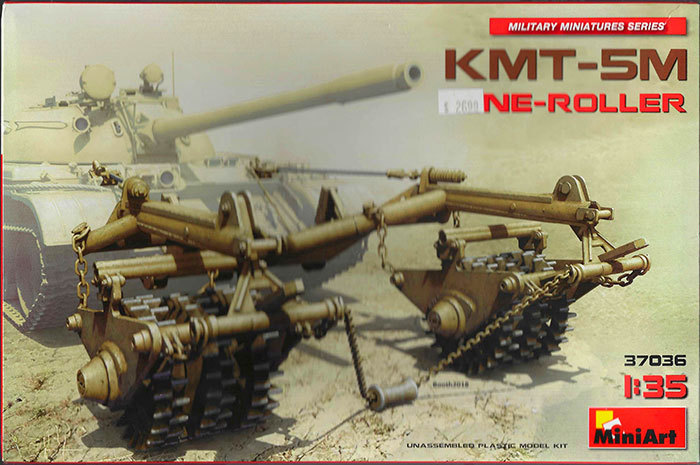
KMT-5M Mine-Roller
MiniArt, 1/35 scale
Reviewed by Cookie Sewell

Summary
| Stock Number and Description |
Miniart 1/35 Scale Kit No. 37036; KMT-5M Mine-Roller; 181 parts (179 in grey styrene, two chains); retail price US$26.99 |
| Scale: |
1/35 |
| Review Type: |
First Look |
| Advantages: |
Easy accessory for any T-54, T-55 or T-62; directions cover installation on any Miniart kit as well as other manufacturers |
| Disadvantages: |
Small parts to connect chains to the linkage may be fragile. |
| Recommendation: |
Highly Recommended for any and all second generation Soviet post-WWII tanks. |

FirstLook
Even during WWI the major nations realized mines were going to become a problem, but not a great deal of research was done on defeating them on the battlefield. But during the Second World War this changed, and all of the major armies did research on devices to either remove or defeat mines found in the path of their forces.
The USSR was no different, and in 1942 fielded the first viable roller system for mine detonation, the PT-3. This consisted of five tank road wheel sized rollers on twin mounts that attached to the front of a T-34 tank with the mine sweeping tank now dubbed a PT-34. Essentially track width rollers, these devices could be used to clear a path by detonating mines in front of the tank. While this was no major problem with anti-personnel mines, antitank mines would damage the system so it had to be repaired or replaced after hitting only 5-6 mines. They called them “wheeled mine trawls” but most other nations simply referred to them as mine rollers.
Research continued in the 1950s and in 1962 they introduced two new sets, the KMT-4 mine plow system and the KMT-5 mine roller system. The mine plow – two track-width shallow depth plows – were used where mines were felt to be hastily emplaced and shallow; the mine roller was used where more long term mine fields were laid. Each required that a tank be fitted with twelve mounts for bolting the assembly to the tank, and required a truck and crane to install them.
Once installed the tank had more restrictive maneuver and could only move at a top speed of 10-12 kph. The system weighed about five tons and could not be lifted once installed by the tank or its crew. The rollers would detonate any mine they managed to trigger by weight and the system permitted the assemblies (one per side) to fly up in the air; the tank could reset them by reversing. Each one was good for about 5-6 antitank mine strikes before the rollers would need replacing.
Another addition from the older PT-3 type was a heavy metal spool on a chain stretched between the assemblies; some nations now were using tilt-rod mines vice pressure plate mines. These had a slender rod about 3mm in diameter that stuck up about 50 centimeters and would trigger the mine when the tank either drove over it or it struck the belly of the tank. This was usually fatal for the crew in the front of the tank.
This system went through a modification to improve its durability and usefulness, but essentially remained the same. When nations began to field magnetic mines, a later improved version, the KMT-7, added magnetic detonators to set them off in advance of the tank. The latest model, the KMT-9, is designed to do the same but permit faster speeds when operating.
Miniart has released kits of all three – the KMT-5M, the KMT-7 (Kit 37045), and the KMT-9 (Kit 37040), but only the KMT-5M is suitable for any T-54/55/62 tank. The kit is a typical Miniart product (read lots of parts and a lot of tiny parts as well) but it does match the prototype fairly well.
The model is designed to provide some movement and flexibility so care is needed during assembly so that the parts work; for example, all three rollers on each set rotate independently of the others. Most of the parts must be trapped in between other assemblies in order to operate so care must be taken during assembly; not all “do not cement” instructions are visible in the directions. Keep in mind that the rollers dangle from the mounts so the chains must be clipped to the mounts via small loops made of styrene and will be somewhat fragile.
Painting them is pretty much up to whatever finish you select for your model that will mount the assembly, e.g. sand, protective green or a camouflage scheme. Miniart provides details on how to fit the assembly to their kits as well as provide add-on bits for fitting it to other manufacturers’ kits such as Takom, Tamiya or Trumpeter.
In summary, this is a nice little accessory for a T-54/55/62 and makes for a different result.
Cookie Sewell
Sprue Layout:
Ac 8x4 Outside rollers, swivels, details
Ag 19x2 Mounts, launching cables, details
Ah 10x2 Hooks, pads, rails
Aj 7x4 Connectors
Ba 14x2 Center roller, axles, details
Bd 21 Frame and mounts
Db 12 Hinges, controls
- 1 Large link chain
- 1 Small link chain
Cookie Sewell
|